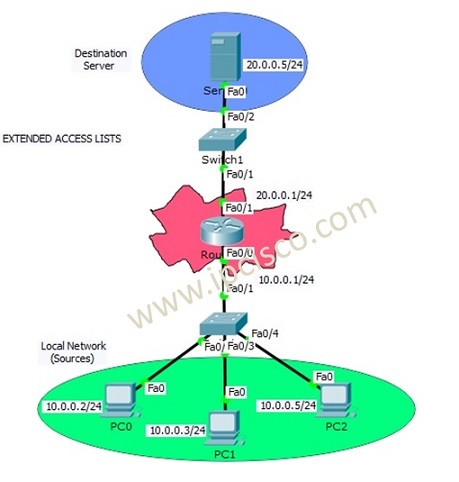- COURSES
- SPECIALS
- BLOG
- MEMBERS
- SHOP
- ABOUT
- ENROLL HERE

Table of Contents
We have learned Access Control Lists overview and Standard ACL Configuration at the previous lessons. In this lesson we will focus on Cisco Extended ACL Configuration with Cisco Packet Tracer. We will use the below topology for our Extended Access List Configuration Packet Tracer Example.
Let’s first remember What is Extended Access Control List? An Extended Access Control List (Extended ACL) is a type of access list used to filter network traffic based on different criterias. Extended Access Control Lists filter traffic with more detailed criteria than a standard ACL. Extended ACL allows to permit or deny traffic based on:
The range of Extended Access Lists are 100-199 are for Numbered ACLs and 2000–2699 for Expanded range.

You can DOWNLOAD the Cisco Packet Tracer example with .pkt format at the End of This Lesson.
Cisco Configurations Course With Packet Tracer
Like Standard ACL Configuration Example, we will use one router, one destination server and 3 PCs in common in this Extended ACL Setup Cisco Packet Tracer. The switches in the topology will onlyu used for port need.
Extended ACLs are a little complex if we compare with Standard ACLs. With Extended ACLs, we can restrict or allow specific things like destination, protocol or port.
In this Cisco Extended ACL Configuration example, we will allow/deny ICMP protocol through the server. As you know, ICMP is ping protocol. Here, PC0 and PC1 will be allowed and PC2 will be denied.
You can also learn DHCP Server Configuration With Packet Tracer
Let’s start to configure router for our Cisco Extended ACL Configuration Packet Tracer Example
For Extended ACLs, we can use Extended Access-List Number range 100 to 199. Here, we will use 100.
Router # configure terminal
Router (config)# ip access-list extended 100
Router (config-ext-nacl)# permit icmp 10.0.0.0 0.0.0.3 host 20.0.0.5
Router (config-ext-nacl)# deny icmp host 10.0.0.5 host 20.0.0.5 host-unreachable
Router (config-ext-nacl)# end
Router # copy run start
You can also DOWNLOAD all the Packet Tracer examples with .pkt format in Packet Tracer Labs section.

Leave a Reply